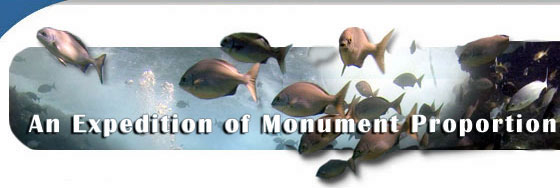|
Mission Log: July 3, 2006
Experiences at the Edge of the Universe
Paulo Maurin
University of Hawai`i
Aboard the NOAA ship Hi`ialakai, we have reached Kure Atoll, the last anchor of the long chain of the Hawaiian Archipelago. Kure Atoll is also the northernmost atoll in the world. Its land area, Green Island, is best described as a bird nest of 320 acres. It has ten thousand Laysan Albatross chicks raised every year, and with their parents and non-breeding adults, can altogether number 50,000. When we add other species (Boobies, Tropic Birds, Terns, Petrels and Frigate birds, among others), we can find over a quarter of a million birds.
 |
| A magnificent sunset is enjoyed by all Kure residents.(Photo: Paulo Maurin) |
We banded 93 of them. Being a member of the education team, we have been snorkeling on what feels are the waters at the edge of the universe – far from anything and everything, clear, and full. And for two blissful days, we were invited to visit Green Island, managed by the State of Hawai`i’s Forestry and Wildlife Division. This terrestrial excursion was engraved on our memories. The grandiosity of the experience was only matched by the amount of preparation for this visit. Kure is the farthest of all of the Northwestern Hawaiian Islands from the Main Hawaiian Islands, and it took us six days of transit to get there. To avoid introducing invasive species, there is a set biological protocol that visitors need to abide by: footwear needs to be brand-new, all clothing item needs to be put in a bag, frozen for 48 hours, and then sealed in a container.
 |
| Standing watch, over the lagoon (note the albatross in the foreground).(Photo: Paulo Maurin) |
We went on a dolphin count, armed with binoculars, cameras with powerful zoom, notebooks, and a depth measuring device. Among the five of us counted a grand total of zero dolphins. That’s a typical day of field biology, since the behavior of wild animals tends to be intrinsically unpredictable. Among the scientists at work was Heather Eijzenga, another graduate student from the University of Hawai`i monitoring seabirds and vegetation on the island.
Our two-day visit was full of activity: we first helped digging a hole in the ground, which has to be several feet deep to reach the atoll’s water lens. This is set to become a small pond, which could be used for future relocation of the Laysan Duck to create a third wild population of this endemic species. We also banded Laysan Albatross, a docile sea bird with an 6-foot long wingspan. We helped clear an invasive species of shrubs, verbicina, a shrub with yellow flowers not unlike a small sunflower, but provides very poor habitat for nesting birds. Unlike the native naupaka shrub, which provides adequate shade within its spacious underside, large enough to provide shelter for the albatross, and its small branches are still strong enough for other birds (such as terns) to nest on top. We cleared a very small area, while much of the inner part of the atoll remains completely covered by it. The open spaces were quickly used by the nearby albatross as a landing and take off area, since these large birds need a runway to perform both maneuvers safely.
 |
| Author, Paulo carefully restraining a Laysan Albatross chick, while State of Hawai`i Wildlife and Forestry worker (behind) bands the leg.(Photo: Ellyn Tong) |
Not all is untouched by us, however far we are from civilization. A somber moment came when we performed a necropsy on a Laysan Albatross chick that had died hours earlier. Its stomach was basically a trash can, full of plastic rubbish. A plastic piece had punctured its stomach and caused the bird to die a painful death. Every now and then you could also see young chicks, obviously unhealthy, with “droppey wings,” wings that are deformed and hang low on young birds’ frame, possibly a result of lead ingestion from the paint of an old tower installed on the island. Even thought it has been long-ago defunct, it still affects the ecosystem decades later.
Evolution theory tells us that, to produce separate species all nature needs is time and isolation. Living at this edge of the universe, for extended periods of time, has created its own human culture too. Its spartan facilities are not for everyone: there is no running water, all power is solar-generated, a toilet out in the open (and you are asked to burn any tissue used, to reduce the volume of waste!). Even though it’s inhabited by only a few people (less than 10) and only during the summer, there are traits of the Kurean people that would be odd elsewhere: on the wall of the main quarters, they have taped a list titled “You Know You Are in Kure If…” which includes: “if you stay inside on a clear day, and go out to work if it’s raining,” and “you ask someone to do a shark-watch while you swim in the lagoon.” Another trait common to the Kureans I met: hard workers, passionate about the work that they do, and in love with the place where they live. After only two short days as their guest, I could sense why its World War II monument declares that “You may leave Kure, but Kure will never leave you.”
|



